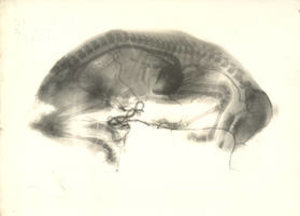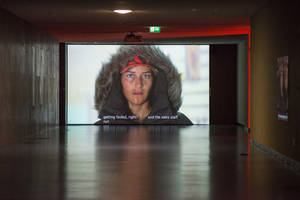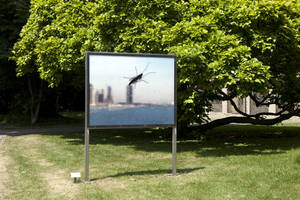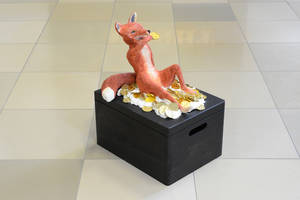15 December 2013 – 16 February 2014
Wozu Bilder?
Gebrauchsweisen der Fotografie
Opening: Sunday, 15 December 2013, 11 am
“What Use Are Pictures?” – especially in today's times, this is a downright radical and simultaneously impertinent question. The same-named exhibition takes as its theme the extremely varied utilizations of photography on the basis of some four hundred photographs from a renowned private collection in southern Germany which are outstanding, even bizarre, sometimes strange, but always astounding.
“Bringing the world home”; “Remembrance”; “Classification”; “Documentation”; “Arousal” – these are a few of the topoi which group examples of historical photography into contentually related picture-tableaus.
“What Use Are Pictures? Utilizations of Photography” at the Villa Merkel turns the customary perspective back onto the medium. The exhibited works have not been selected according to what may be seen upon them or what subjects they offer, but instead with a view to their forms of utilization and application, which are brought to light across a broad spectrum. There are such uses, for instance, as that with the help of photography, nature can be investigated or romanticized, people may be called to mind or traced by the police. Entertaining items may be found under the heading “Jokes.”
These are pictures which cause amusement, induce laughter. They already existed long before the invention of photography. But only photography makes it possible (through montage, multiple lighting, etc.) to allow a lady to engage in a game of chess with herself. Photography has the capacity for making the impossible seem credible …
The exhibition and publication was developed over the course of a two-semester project at the Universität Konstanz in winter 2012/13 and summer 2013 under the supervision of the instructors Bernd Stiegler and Felix Thürlmann.
The exhibition and publication Wozu Bilder? Gebrauchsweisen der Fotografie is receiving generous financial support from the Innovationsfonds Kunst of the State of Baden-Württemberg and, in the context of the initiative of excellence of the Federal Republic and the Federal States, from the cluster of excellence Kulturelle Grundlagen von Integration of the Universität Konstanz.
15 December 2013 – 16 February 2014
Stefan Panhans
Schnee schnell Schnee Du bleiches Reh
Opening: Sunday, 15 December 2013, 11 am
In filmic works, photographs, and installations, Stefan Panhans (*1967) develops pictorial worlds oscillating between documentation and artificiality. Articles from the world of urban consumption such as brand-name gym shoes, fitness equipment, and granola mixtures serve as props in photographic still lifes or are parts of a meticulously prepared décor for film sets. Moving in these scenarios are mask-like, artificial figures that seem to have lost their way between lifestyle, self-optimization, and media hype.
The videos of Stefan Panhans are shot in a single take and do not adhere to a narrative logic. The concentration is upon a pictorial language and carefully staged monologues and dialogues. There is frequent use of sampling techniques which take up advertising slogans, slang expressions, or marketing language. In the video “ Sieben bis Zehn Millionen” (“Seven to Ten Million”), for example, a person describes at breakneck speed the complications which can arise when purchasing technical equipment. Only upon a second look does the face of the speaking man, wrapped in a fashionable hood with fur collar, reveal itself to be that of a woman. The viewer himself is manipulated in ambivalent images which conceal several layers behind their superficially shining advertising optics.
The photographs as well are unexpected stagings of contemporary lifestyle and a persiflage on the mechanisms of advertising photography. For the exhibition at the Villa Merkel, a series of photographs have been newly produced and are being presented for the first time.
The video “Sorry” has almost no language at all. It takes place in the overcrowded pullman car of an intercity express train. People shove their way past each other and climb over heaps of gaudily colored luggage. An everyday image in a second-class carriage of the German Railway—if it were not the case that every person is wearing an exaggerated costume inspired by a role model from the world of art and media. Things which seem to have no affinity with each other are fitted together into an opulent image of our era.
These are pictures which cause amusement, induce laughter. They already existed long before the invention of photography. But only photography makes it possible (through montage, multiple lighting, etc.) to allow a lady to engage in a game of chess with herself. Photography has the capacity for making the impossible seem credible …
The exhibition and publication was developed over the course of a two-semester project at the Universität Konstanz in winter 2012/13 and summer 2013 under the supervision of the instructors Bernd Stiegler and Felix Thürlmann.
The exhibition and publication Wozu Bilder? Gebrauchsweisen der Fotografie is receiving generous financial support from the Innovationsfonds Kunst of the State of Baden-Württemberg and, in the context of the initiative of excellence of the Federal Republic and the Federal States, from the cluster of excellence Kulturelle Grundlagen von Integration of the Universität Konstanz.
19 July – 6 October 2013
Crossing Media – A Stage for Art
Opening: Thursday, 18 July 2013, 7 pm
Including works by Nevin Aladag (TR/DE), Julien Berthier (FR), Birgit Brenner (DE), Daniele Buetti (CH), Kurt Caviezel (CH), Beate Engl (DE), Rainer Ganahl (AT/US), Johan Grimonprez (BE), Paul Harrison/John Wood (GB), Christine Hill (US), Eva Kotatkova (CZ), Jung Lee (KR), Alexandra Leykauf (DE), Atelier van Lieshout (NL), Andres Lutz/Anders Guggisberg (CH), Philippe Ramette (FR), Banks Violette (US).
„Crossing Media – Der Kunst die Bühne“ [the stage given over to art] is an attractive festival of contemporary Art in Esslingen which has developed out of the International Foto Triennale. In 2013 the galleries of the city of Esslingen have focused increasingly on positions of the crossover, which, starting off from photographic approaches, provide a stage for performance and interactive tendencies on an equal footing. The art and media Triennale is building bridges between disciplines and genres, in which visual arts is related to theatre, music and language. Artistic positions of photography, video arts, installation down to performance that will be presented.
In the interplay of artistic approaches there lies the potential of testing unknown territory, of questioning social relations and further developing traditional genres. On the basis of photographs, Alexandra Leykauf
These are pictures which cause amusement, induce laughter. They already existed long before the invention of photography. But only photography makes it possible (through montage, multiple lighting, etc.) to allow a lady to engage in a game of chess with herself. Photography has the capacity for making the impossible seem credible …
The exhibition and publication was developed over the course of a two-semester project at the Universität Konstanz in winter 2012/13 and summer 2013 under the supervision of the instructors Bernd Stiegler and Felix Thürlmann.
The exhibition and publication Wozu Bilder? Gebrauchsweisen der Fotografie is receiving generous financial support from the Innovationsfonds Kunst of the State of Baden-Württemberg and, in the context of the initiative of excellence of the Federal Republic and the Federal States, from the cluster of excellence Kulturelle Grundlagen von Integration of the Universität Konstanz.
28 April – 30 June 2013
Manfred Kuttner
Werkschau
Opening: Sunday, 28 April, 11 a.m.
Manfred Kuttner (1937-2007) was one of the co-founders of Capitalist Realism. In 1963 he organised the legendary Demonstrative exhibition in the Kaiserstraße, Düsseldorf, together with his artist friends and colleagues Konrad Lueg, Sigmar Polke and Gerhard Richter. The exhibition can be seen as the nucleus of the so-called German Pop Art and of the worldwide success of Sigmar Polke, Gerhard Richter and the later gallery owner, Konrad Fischer. In 1967 Manfred Kuttner moved into the field of advertising art, ending his artistic career almost before it had properly begun.
The abstract, geometrically structured pictures and neon-coloured objects of Manfred Kuttner from the early 60s range ambivalently between such different styles as Op art, Pop art, Zero art, Informel and Nouveau Réalism. His use of the then brand-new Plaka fluorescent paint created a shimmering surface, invalidating attempts at classification.
These are pictures which cause amusement, induce laughter. They already existed long before the invention of photography. But only photography makes it possible (through montage, multiple lighting, etc.) to allow a lady to engage in a game of chess with herself. Photography has the capacity for making the impossible seem credible …
The exhibition and publication was developed over the course of a two-semester project at the Universität Konstanz in winter 2012/13 and summer 2013 under the supervision of the instructors Bernd Stiegler and Felix Thürlmann.
The exhibition and publication Wozu Bilder? Gebrauchsweisen der Fotografie is receiving generous financial support from the Innovationsfonds Kunst of the State of Baden-Württemberg and, in the context of the initiative of excellence of the Federal Republic and the Federal States, from the cluster of excellence Kulturelle Grundlagen von Integration of the Universität Konstanz.
28 April – 30 June 2013
Lena Münch
Splinters. Photography and Things
Opening: Sunday, 28 April 2013, 11:00 a.m.
Debut exhibition in the Bahnwärterhaus
‘Lena Münch – Splinters. Photography and Things’ is the second debut exhibition this year in collaboration with the Staatliche Akademie der Bildenden Künste in Stuttgart.
In analogue photographs done in black and white, Lena Münch combines and varies in complex ways her impressions, experiences and perspectives regarding the world. The material serving as the point of departure for her artistic oeuvre most often consists of found and everyday objects. Lena Münch uses these seemingly unconnected, partially antagonistic raw materials – the metaphorical splinters of the world – to construct with technical skill temporary and atmospheric realities.
The arranged photographs are characterised not only by a high degree of precision but also by a freedom in their intuitive handling of random occurrence. With photographic techniques ranging from the classical to the experimental, Lena Münch playfully assembles objects into precise pictorial compositions. The objects and forms are set into relation to each other and take on the role of protagonists in the composition as if in a theatre of light and darkness.
There arise both countless and constructive pictorial worlds in contrasting spaces of black and white. But it is not only in the photograph that the objects assert their haptic presence: they lay claim to space. In the exhibition space, they are sometimes even a quotation of the photographic image or actual material in the world.
Lena Münch (*1980 in Stuttgart) studied from 2003 to 2009 at the Staatliche Akademie der Bildenden Künste in Stuttgart and at the Accademia delle Belle Arti di Brera in Milan. She attended classes in free graphic art, painting and sculpture with Prof. Andreas Opiolka, Prof. Franco Marrocco, Prof. Paolo Gallerani, Prof. Reto Boller et al.
Appearing on the occasion of the exhibition is a hybrid out of picture book and catalogue entitled ‘Das mit dem Leben und der Liebe’ (‘That Thing about Life and Love’). The artist presents therein a pictorial narrative weaving together her observations, experiences and dreams.
17 February – 14 April 2013
Goldrausch
contemporary art made from, with or about gold
Opening: 17 February 2013 11 a.m.
Villa Merkel
Pawel Althamer, Joseph Beuys, Michał Budny, Anja Ciupka, Jürgen Drescher, Felix Gonzalez-Torres, Filip Gilissen, Daniel Knorr, Alicja Kwade, Kris Martin, Jonathan Monk, Alexandra Müller, Roman Ondák, Martin Pfeifle, Claus Richter, Michael Sailstorfer, Johannes Vogl and Claudia Wieser
In cooperation with Kunsthalle Nürnberg, Nuremberg
18 October 2012 to 13 January 2013
Curator of the exhibition: Dr. Harriet Zilch
www.kunstkulturquartier.de/kunsthalle
Catalogue German/English
Verlag für moderne Kunst Nürnberg
ISBN 978-3-86984-387-2
24,- Euro during the exhibition at Villa Merkel
32,- Euro in bookshops
17 February – 14 April 2013
Julien Viala
The memory of space
Debut exhibition in the Bahnwärterhaus
Stuttgart State Academy of Art and Design
The exhibition ‘Julien Viala. The memory of space’ marks the start of a new series of projects. In the future, two respective debut exhibitions will take place in the Bahnwärterhaus each year in collaboration with the Stuttgart State Academy of Art and Design. The exhibition of Julien Viala (*1978 Munich) consists of objects, artefacts, photographs, installations and projections. Transcending genres, the works include areas such as architecture, design and sculpture. The individual parts become mutually connected in site-specific arrangements which are imbued with an artificial atmosphere through illuminated projections. The viewer has the impression of stepping onto a stage from the rear.
Julian Viala thematises the shift between the reality and appearance of a site. The sculpturally oriented spatial compositions point towards possible or also feigned functions which are also associated with the special site of the Bahnwärterhaus. A precise definition is not provided, however. The objects conjoin so as to convey an open overall impression and give space to deception and improbability.







































